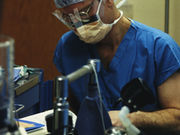Small improvement seen over one year in early study
THURSDAY, April 6, 2017 (HealthDay News) — Stem cell-sheet transplantation shows promise in the treatment of cardiomyopathy, according to research published online April 5 in the Journal of the American Heart Association.
In the new study, researchers used stem cells from the patient’s own thigh muscle to create a patch they placed on the heart. That’s in contrast to many past studies, where researchers have injected stem cells — often from a patient’s bone marrow — into the heart. The patch tactic could have some advantages, senior researcher Yoshiki Sawa, M.D., Ph.D., of Osaka University in Japan, told HealthDay. He said animal research suggests that cells in sheet form survive for a longer period, compared to injections.
To test the safety of the approach, Sawa’s team recruited 27 patients who had debilitating symptoms despite standard heart failure therapies (15 ischemic cardiomyopathy patients and 12 patients with dilated cardiomyopathy). The scientists extracted stem cells from each patient’s thigh muscle, then cultured the cells so that they formed a sheet. The sheet was placed on each patient’s heart. The process appeared safe, the researchers said, and there were signs of symptom improvements over the next six months to a year.
The stem cells don’t grow into new heart muscle cells. Instead, Sawa explained, they seem to produce cytokines that can promote new blood vessel growth in damaged areas of the heart. The theory, he said, is that “hibernating” cells in the heart muscle can then function better.
The authors’ laboratory received funding for cooperative research in cell sheet from the TERUMO Company.
Copyright © 2017 HealthDay. All rights reserved.








